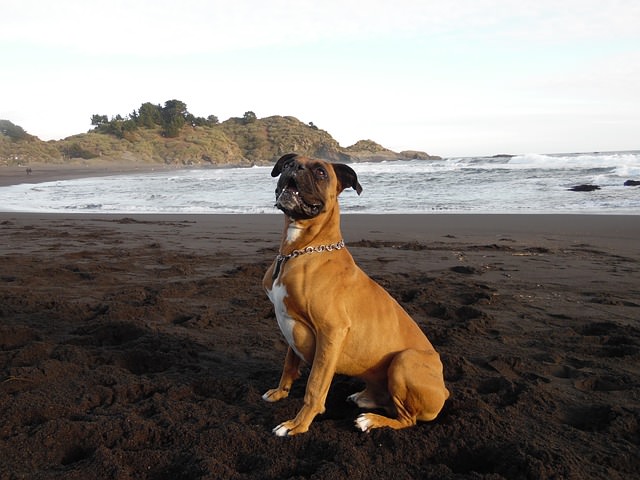Boxers have a hard time learning “stay.” It involves not moving for a long period of time and this is difficult for their bouncy selves. In reality, it’s hard for any dog. Have you tried sitting almost stock still for any length of time? It’s hard for us too. The following method will make teaching “stay” to your Boxer easier. It will also produce a more reliable “stay” that your Boxer does not break, no matter the distractions that come his way.

Duration & Distance
To make “stay” training easier for your Boxer, you are going to break it up into the following three parts: duration, distance, and distractions. First, you are going to work on just duration and then just distance. Finally, you will add distractions once a solid stay has been taught.
When starting, don’t use your “stay” cue. We will add this later once your Boxer knows the behavior.
Start by building up duration – how long your Boxer can sit in one position. Do this in small increments by asking your dog to sit then counting to one second and rewarding. Then count to two seconds and reward. At this point, release your dog by saying your release cue (common ones are “okay,” “free,” “break,” and “release”), and tossing a treat for your dog to get. Then you can start over, gradually building up duration.
Ideally, your Boxer will never break his “stay” using this method. If he does, just put him back in a “sit,” count a second or two depending on where you are in your training and then reward.
In the beginning, do short training sessions in a quiet room with little to no distractions.
Do the same thing with distance by taking steps away from your Boxer and returning to reward. Again, no cue for “stay.” Don’t forget to use your release cue every time you end the stay.
Adding the Cue
Once you can count to around 10-15 seconds and take at least 5 steps away from your Boxer without him getting up, you can start adding the cue. To do this, say “stay” (or whatever cue you wish) while your dog is in the middle of an exercise, then return and reward.
Distractions
Once the cue has been added, it’s time to start adding in distractions that your Boxer will have to ignore while keeping his “stay.” The younger your Boxer is, the more slowly you will probably have to add distractions.
What is a hard distraction for one Boxer may be easy for another, so think about what gets your dog excited. Anything that excites your Boxer will make him want to break his “stay.” Start with something your Boxer doesn’t find that interesting. Maybe another family member walking by, the TV on, or a toy (not being thrown, just holding it). Basically, anything that is a bit of a distraction, but not your dog’s favorite thing on Earth.

Build up slowly to:
- Tossing a toy.
- Tossing a treat.
- Kids – walking, laughing, running etc.
- Other dogs – walking by, doing stays next to them, etc.
- Other animals – cats, squirrels, etc.
- People – greeting, walking by, etc.
- New places – pet stores, parks, etc.; long lines are great for practicing stays in public places.
- Cars – this can be hard for dogs that like to chase, for some dogs it’s no big deal.
If your dog breaks his “stay” three times in a row when you add a new distraction, he is not ready for that one. Remove it and try something that’s in-between his last successful distraction and the one he failed. So, for example let’s say your Boxer was fine with you holding a ball but when you threw it, he failed. Next time you might try dropping or placing it on the ground, rolling it slowly, or tossing it gently so it goes a foot or two. The goal is to make your Boxer successful. Follow these simple steps, and you will have a rock-solid “stay.”
